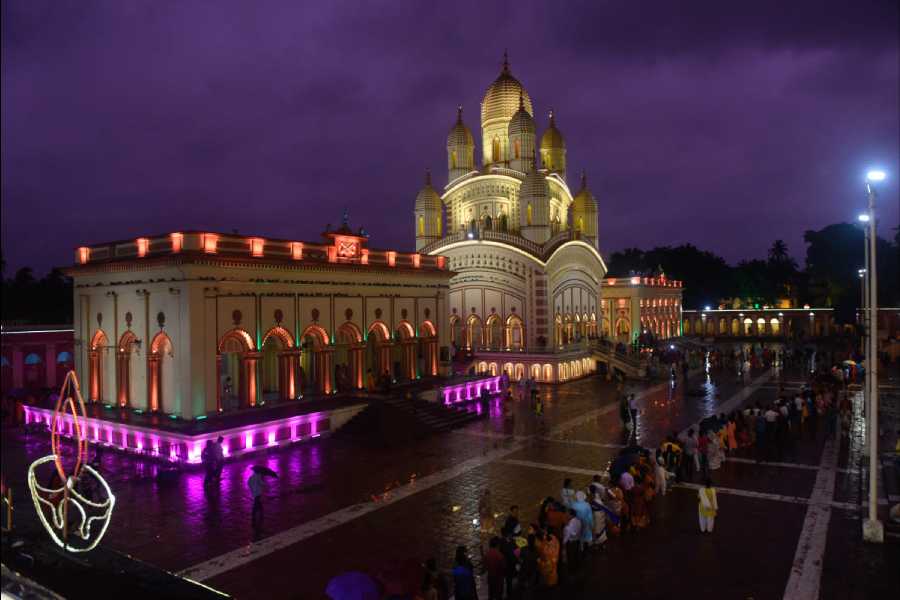The Dakshineswar Kali Temple, a storied Hindu shrine that is as frequent a destination for senior political leaders as ordinary devotees, had a syncretic beginning.
According to the temple trust, a part of the land where the shrine stands today was a Muslim graveyard, another part belonged to a European Christian and the rest was
a mango orchard owned by a Hindu family.
Rani Rashmoni, the temple’s founder, acquired the land and “began to construct this Hindu temple in 1847 on this very ground thus integrating different faiths”, says the temple trust’s website.
The feisty widow of zamindar Babu Rajchandra Das of Janbazar, central Calcutta, established the temple on the Hooghly riverfront on May 31, 1855, to fulfil the wishes of her late husband.
“The exceptionally open-minded Rani wished that pilgrims of all religions and castes could offer prayers at the temple,” the website says.
The temple’s foundation, however, faced an unexpected hitch. Because the Rani was a widow and belonged to a caste perceived to be low, orthodox Hindu priests refused to perform rituals at the goddess’s altar. Finally, Ramkumar Chattopadhyay, a Brahmin from a remote village in Hooghly district, accepted her offer to be the chief priest.
Later, Ramkumar’s younger brother Gadadhar — who would become the mystic saint Ramakrishna — became the priest.
Ramakrishna, an ardent devotee of Kali, expounded the philosophy of “joto mot, toto poth” (there are as many paths as there are faiths) while performing his sadhana, or spiritual practice, in the temple compound and its garden, Panchavati.
Standing at the entrance of the temple today, it’s difficult to imagine what Rani Rashmoni would have seen when she stepped on the premises for the first time.
Today, a police outpost stands at the entrance. Beside it is a security enclosure where visitors have to deposit their mobile phones and belongings. Body scanners and metal detectors have been installed at the entry point.
Scores of private security guards keep vigil on visitors. The western gate is sealed and the Panchavati garden in the north cannot be accessed, either.
Concrete structures and iron grills, acres of paved parking lots, and barricades here and there — that is the Dakshineswar Kali Temple today, or at least the approach to it. Inside, it’s a veritable fortress.
Gone are the days when one could casually step into the expansive courtyard, walk unhindered intothe hallowed portals, roam freely in the garden outside, or enjoy the peace and quiet, undisturbed by the public address system.
Not that any of it has affected the footfall of pilgrims. The temple draws millions, if not crores, of Kali devotees every year. The volume has increased since the temple complex was connected to the North-South Metro in 2021, just ahead of the Assembly elections.
Arun Chakraborty, a resident of Ariadaha which is close by, misses the “Kalibari” of his childhood when one could simply walk in and pray to the goddess. He rarely offered a formal puja, mostly visiting the temple to seek solace during times ofgrief or worry.
Now, only those who offer puja can approach the deity, but they have to queue up.
For the elderly, standing in the interminable queues can be an ordeal. It took Purba Chatterjee, a resident of Chandannagar, and her septuagenarian mother over an hour to reach the sanctum sanctorum. “And when we did, within seconds the guards shoved us aside,” Chatterjee said.
The gate connecting the bathing ghat to the temple was closed a few years ago. Jayanti Dutta from Maniktala said there was a time when she would undertake a fast, and on reaching Dakshineshwar bathe atthe ghat. Thus “purified”, she would walk straight to the deity.
Other devotees miss the access to the room of Ramakrishna in the northwest corner of the temple complex. This is the room where Swami Vivekananda and other devotees received his kathamrita or sermons.
Dilip Das, a resident of nearby Baranagar, used to meditate in this room at least once a week even five years ago. The atmosphere inside gave him a feeling of“spiritual trek”.
“Now you can only peep from a distance,” Das said.
Some people are happy to approach the temple via the new skywalk, inaugurated ahead of the 2019 Lok Sabha elections. It’s an elevated walkway, connecting the shrine complex to the road and railway station.
“You are no longer pestered by hawkers or beggars on the way,” said Kanchan Dhar, a resident of central Calcutta.
Others are thrilled by the arcades earmarked for selling puja items, mementos and foodstuff. “It’s an orderly pilgrimage now, clean and disciplined. Robust security protects the temple against possible terrorist attacks,” Dhar said.
But the majority among those who have been frequenting Dakshineswar for decades no longer find the old serenity or “spiritual bliss” in the temple air.
“You can’t meditate in peace anywhere in the compound. It’s too crowded,” said Soma Majumdar, a resident of Bally across the river.
She yearns for the white temple of yesteryear, now painted a loud yellow ochre and dark maroon. Devotees like her feel there is a barricade between them and the “Divine Mother” now.
Not everyone worries about such things. Rani Rashmoni’s dream temple is now a leading Hindu pilgrimage site. Visitors from all faiths are still welcome to its portals. It has also turned into the first port of call for various political leaders looking for publicity before elections.
Dakshineswar falls in the Dum Dum constituency, which voted on Saturday










